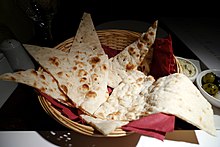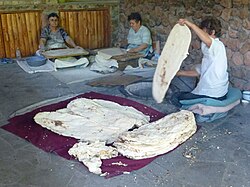Lavash
Lavash is a thin flatbread[1] usually leavened, traditionally baked in a tandoor (tonir or tanoor) or on a sajj, from the South Caucasus, West Asia, and the areas surrounding the Caspian Sea.[2][3][4] Lavash is one of the most widespread types of bread in Armenia, Azerbaijan, Iran and Turkey.[5] The traditional recipe can be adapted by using a griddle or wok instead of the tonir.[6]
 | |
| Type | Flatbread |
|---|---|
| Region or state | West Asia |
| Serving temperature | Hot or cold |
| Lavash, the preparation, meaning and appearance of traditional bread as an expression of culture in Armenia | |
|---|---|
 Lavash making in Armenia | |
| Country | Armenia |
| Domains | Food |
| Reference | 985 |
| Region | Europe and North America |
| Inscription history | |
| Inscription | 2014 (9th session) |
| Flatbread making and sharing culture: Lavash, Katyrma, Jupka, Yufka | |
|---|---|
 | |
| Country | Azerbaijan, Iran, Kazakhstan, Kyrgyzstan and Turkey |
| Domains | Food |
| Reference | 1181 |
| Region | Europe and North America |
| Inscription history | |
| Inscription | 2016 (11th session) |
History
changeGil Marks traces the history of lavash to the early innovation of cooking thin flatbreads on terracotta griddles. The earliest forms of bread were cooked as cakes either on heated rocks or in embers, but when griddles started to be used breads had to be made thinner to fully cook through without burning like the bread rakik described in the Bible. With the innovation of early ovens, thicker loaves became possible.[3]
The origin of lavash is often attributed to Armenia,[7][8][9][10] or Iran.[11][12][13] Food historian Gil Marks identifies the origin more generally as the Middle East.[3]
Preparation
changeLavash is made with flour, water, yeast, sugar and salt. It can also be made in an unleavened version by omitting sugar and yeast.[14] Toasted sesame seeds and/or poppy seeds are sometimes sprinkled on before baking. Traditionally the dough was rolled out flat and slapped against the hot walls of a clay oven.
Usage
changeWhile quite flexible when fresh, lavash dries out quickly and becomes brittle and hard. The soft form is easier to use when making wrap sandwiches.
In Armenian villages, dried lavash is stacked high in layers to be used later, and when the time comes it is sprinkled with water to make it softer again. The dried bread is broken up into khash (խաշ), while fresh lavash is used to wrap the Armenian specialty dish khorovats and to make other wraps with herbs and cheese.
In Iran, Turkey and some Middle Eastern countries lavash is used with kebabs to make dürüm wraps like tantuni. In its dry form, leftover lavash is used in Iran to make quick meals after being rehydrated with water, butter, or cheese.
In Turkey lavaş are used for sweet dishes and served alongside some traditional Turkish dessert dishes like kaysefe, hasude, pestil kavurması ('braised fruit leather'), ağuz and helva.[15]
In Kashmiri cuisine, lavas is traditionally used with the morning tea, also known as Noon Chai or Sheer Chai.[16][17]
Traditions and customs
changeIn Armenian weddings, it is traditional for the mother of the groom to feed the newly wed couple lavash and honey as a wish of good fortune, fertility and sweetness for the couple. Dried lavash can be stored for nearly a year and is used instead of leavened bread in Eucharist traditions by the Armenian Apostolic Church.
In Sabirabad District of Azerbaijan after a wedding when the bride comes into her new house, her mother-in-law puts lavash on her shoulder and says: "Let you come to the house of wealth, let your foot be lucky".[19] In the Novkhani settlement, after a funeral, it is customary for people to prepare kyulchya, which sometimes consists of halva wrapped up in lavash.[20]
In art
changeWomen baking lavash is a common theme that has inspired Armenian painters. One such portrait by the famous Soviet-era painter Minas Minassian is displayed at the National Museum of Art in Yerevan. A print of the painting Armenian Ladies Baking Lavash by Armenian American artist Manuel Tolegian was selected by U.S. President Gerald Ford to hang in the White House Bicentennial Collection. The weekend open-air arts-and-crafts market in downtown Yerevan offers many lavash-related paintings and handiworks. Pictures of happy women making lavash are a common sight.[21]
Related pages
changeReferences
change- ↑ Kipfer, Barbara Ann (2012-04-11). The Culinarian: A Kitchen Desk Reference. Houghton Mifflin Harcourt (published 2012). p. 334. ISBN 9780544186033. Retrieved 2015-06-01.
LAVASH, LAVOSH, LAHVOSH, LAWAASH, or LAWASHA, also called ARMENIAN CRACKER BREAD, CRACKER BREAD, or PARAKI, is a round, thin Middle Eastern bread that is soft like a tortilla or hard like a cracker.
- ↑ Alan Davidson (1999). The Oxford Companion to Food. Oxford University Press. p. 456. ISBN 978-0192806819.
Lavash a thin crisp bread usually made with wheat flour made in a variety of shapes all over the regions of the South Caucasus, Iran (where it is often so thin as to be like tissue and can be almost seen through), and Afghanistan. It is leavened and baked in a tandoor. Lavash is served with kebabs and is used to scoop up food or wrap round food before being eaten. Its origins are ancient and it is also known as lavaş depending on the region. As in the other countries of this region large batches of this bread are made and stored for long periods. In Turkey they are stored on a board suspended by all four corners from the ceiling. The bread becomes dry and is restored by sprinkling with water and reheated as and when needed. Yufka is also a name for filo pastry.
- ↑ 3.0 3.1 3.2 Gil Marks (2010). Encyclopedia of Jewish Food. John Wiley and Sons. p. 355.
- ↑ Morgan, Diane (2010). Skinny Dips. Chronicle Books. p. 14. ISBN 978-1452100241.
Lavash, lavosh, or lahvosh is a gigantic, paper-thin, blistery, tortilla-like flatbread common throughout Armenia, Turkey, and Iran.
- ↑ "Tastes of Memory: How to Bake an Authentic Armenian Lavash". Smithsonian.
- ↑ "Lavash". February 26, 2020.
- ↑ Sergio O. Serna-Saldivar (2012). Cereal Grains: Laboratory Reference and Procedures Manual. CRC Press. p. 217. ISBN 9781439855652.
Lavash is another popular flat cracker bread with ancient roots in Armenia.
- ↑ Albala, Ken (ed.). Food Cultures of the World Encyclopedia, Volume 1. Santa Barbara, California: Greenwood Press. p. 5. ISBN 9780313376269.
...on lavash, a traditional flatbread of Armenia similar to tortilla...
- ↑ Goldstein, Darra (1999). A Taste of Russia: A Cookbook of Russian Hospitality (2nd ed.). Montpelier, VT: Russian Life Books. p. 185. ISBN 9781880100424.
Armenian Flat Bread Lavash: Lavash has been baked for centuries in Armenia.
- ↑ Khanam, R. (2005). Encycl. Ethnography Of Middle-East And Central Asia (3 Vols. Set) (1st ed.). New Delhi: Global Vision. p. 55. ISBN 9788182200623.
The t'onir is a round hole dug in the ground, which can be used for baking Armenian flat bread (lavash) and for heating the home in winter.
- ↑ Karizaki, Vahid Mohammadpour (2017-03-01). "Ethnic and traditional Iranian breads: different types, and historical and cultural aspects". Journal of Ethnic Foods. 4 (1): 8–14. doi:10.1016/j.jef.2017.01.002. ISSN 2352-6181.
The origin of lavash is most probably from Iran, according to the state of the encyclopedia of Jewish food.
- ↑ Marks, Gil (2010). Encyclopedia of Jewish Food. Houghton Mifflin Harcourt. p. 355. ISBN 978-0470391303.
- ↑ Reinhart, Peter (2011). The Bread Baker's Apprentice: Mastering the Art of Extraordinary Bread. Potter/TenSpeed/Harmony. p. 178. ISBN 978-1607741299.
Lavash, though usually called Armenian flatbread, also has Iranian roots (...)
- ↑ "Mayasız lavaş ekmek tarifi". www.hurriyet.com.tr. 16 April 2020.
- ↑ Her Yönü ile Ani. TTOK. 2019.
- ↑ "From Lavasa to Sheermal: Journey Through Kashmir's Bread Culture". Slurrp. Retrieved 2024-03-08.
- ↑ Gull, Murtaza (2019-01-12). "Into The Heart of Kashmir Culture- Kashmiri Bakery". The Kashmiriyat. Retrieved 2024-03-08.
- ↑ Shulman, Martha Rose (2010-10-26). "Lavash Pizza With Tomatoes, Mozzarella and Goat Cheese". The New York Times.
- ↑ Кулиева Н. М. Современная сельская семья и семейный быт в Азербайджане / Под ред. доктора исторических наук Т. Г. Мусаевой. — Б.: «Элм», 2011. — С. 97.
- ↑ Кулиева Н. М. Современная сельская семья и семейный быт в Азербайджане / Под ред. доктора исторических наук Т. Г. Мусаевой. — Б.: «Элм», 2011. — С. 122.
- ↑ "Lavash". Archived from the original on 2022-02-13. Retrieved 2021-07-28.